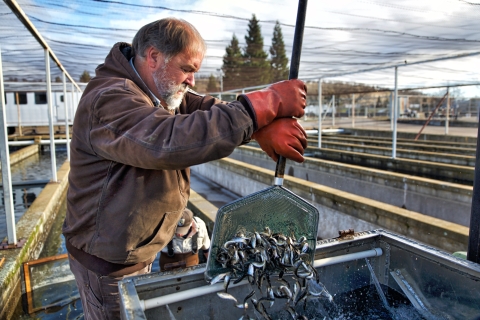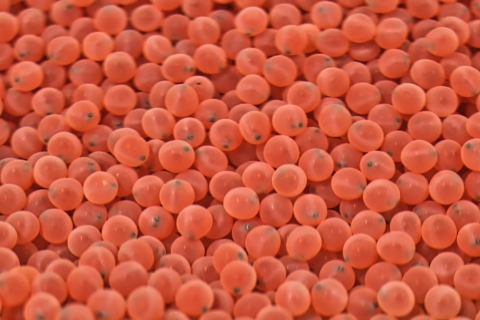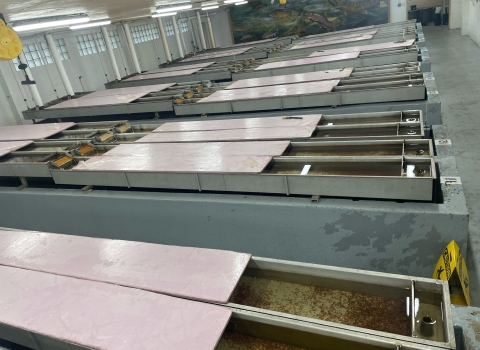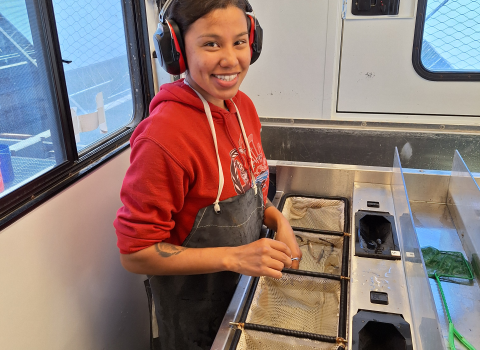Robert Barker, a fish culturist at the Coleman National Fish Hatchery, had just helped complete something historic and he knew it, spontaneously raising his arms in touchdown-like fashion.
“I was thinking “yeaaaa! We did it!” Barker said.
Barker’s enthusiasm was shared by many. He was directing the release hoses that had just helped reintroduce 29,000 Sacramento River endangered winter-run Chinook salmon into a restored section of the Battle Creek tributary on the upper Sacramento River for the first time since the 1990s.
The reproductively mature adults in a population that breed (or spawn) and produce more individuals (offspring or progeny).
Learn more about broodstock program.
The juveniles released the morning of March 2 were the first group from the approximately 215,000 fish that were the result of a captive broodstock program at Livingston Stone National Fish Hatchery managed by the U.S. Fish and Wildlife Service. The release, which has received national attention, reached a major milestone reached after years of rearing the fish and its listing as an endangered species under both federal and state law.
The project was a multi-agency effort to plan and restore the Battle Creek salmon and steelhead habitat, marking a major step forward toward the species recovery.
“We’re calling this project the ‘Battle Creek winter-run jump start,’” said Jim Smith, project leader for the Red Bluff Fish and Wildlife Office. “We felt these additional fish could help bolster the winter-run population and be a potential catalyst in their recovery.”
Battle Creek flows through Shasta and Tehama counties and is the location of the Battle Creek Salmon and Steelhead Restoration Program, comprised of the resource managers from the California Department Fish and Wildlife, the U.S. Fish and Wildlife Service, the Bureau of Reclamation, NOAA Fisheries, and the Pacific Gas and Electric Company, who all worked for years on the program.
The partner agencies considered the additional broodstock and eventual releases as a key opportunity to expand the current range of the imperiled fish.
After that first group was released into the North Fork of Battle Creek at Wildcat Bridge near Manton, California, much-needed wet weather conditions and flows ensued, and the remaining 185,000 fish followed, with about 92,000 going out from the raceways at Coleman on March 14, followed by another 67,000 on March 16.
The remaining 26,000 are expected to be released before the end of March, once they reached the required size needed to endure the tough conditions in Battle Creek.
“We switched gears a little but the conditions have been perfect for release,” said Brett Galyean, Coleman’s hatchery manager, breathing a big sigh of relief.
The road to reestablishing the fish in Battle Creek has been long. The broodstock program began in 1992 to address the collapse of winter-run Chinook salmon abundance in the Sacramento River throughout the 1980’s and early 1990’s. Because the winter-run Chinook salmon population rebounded in the early 2000’s, the captive broodstock program was suspended.
However, with the loss of nearly the entire in-river juvenile population in 2014 and 2015 due to the extreme drought, the captive program at the hatchery was reinstituted. Approximately 1,000 fish are retained in the hatchery each year and raised to adults for breeding.
Salmon were hatched from broodstock adults last August at the Livingston Stone near Shasta Dam and trucked to Coleman, which is located on Battle Creek.
The fish were transferred quickly to Coleman so the growing juveniles could be imprinted in the waters of Battle Creek, helping them to find their way back to Coleman as adults in two and three years. About 230,000 eggs and fry were taken last summer from Livingston Stone to Coleman, Galyean said.
All of the juvenile salmon released were tagged and fin clipped prior to release, allowing resource managers to track their survival, growth and ocean distribution, as well as to detect them when they return to Battle Creek.
Meanwhile, the North Fork of Battle Creek is historic habitat for winter-run Chinook salmon that has received significant improvement as part of a long-term restoration project that included building fish dams and removing debris to increase flows.
“This is our attempt to ‘jump start’ the recovery of Sacramento River winter-run Chinook salmon by expanding their range into a watershed that has undergone substantial habitat restoration over the past several years,” said Maria Rea, assistant regional administrator for NOAA Fisheries Central Valley Office. “We have been preparing a comprehensive plan for reintroduction of these fish and are excited that this opportunity to use the 2014 cohort of captive broodstock allows us to begin implementation this year.”
Another reason the Battle Creek releases were important: NOAA Fisheries considers winter-run Chinook salmon among eight marine species most at risk of extinction and part of the “Species in the Spotlight” initiative.
“Each step we take to re-establish these endangered winter run Chinook salmon is vital and helps us remember that in less than a century a run of salmon nearly a million strong has been reduced to thousands,” said California Department of Fish and Wildlife director, Charlton H. Bonham. “Each effort we make takes us a step closer to returning more of these iconic fish to our state.”
With the Coleman complex, which includes Livingston Stone, playing a vital role in the broodstock and release program, Galyean said he appreciates the cooperation required to make the project a success.
“I want to thank everyone that has been involved with this project and acknowledge how far we have come since the initial planning meeting last summer on what to do with the captive brood stock at Livingston Stone,” Galyean said.
“In my opinion the jumpstart program is the only good thing that came out of the drought for north state salmon.”







